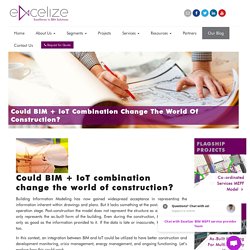

Excelize Software Pvt. Ltd.
Excelize is not just an engineering services firm, it is a veritable support system that provides Building Information Modeling(BIM) services to offshore architecture, engineering, construction (AEC) businesses.
The Secret to Higher Performance and Lower Cost Construction Projects. Why you need construction sequencing management? Construction sequencing and scheduling requires you to plan construction activities while considering resources, spatial constraints, and other concerns.

Scheduling and sequence analysis in construction guarantees that staging is streamlined and identifies potential conflicts. Construction sequencing usually requires scheduling and sequencing software to create, update, and communicate the project plan to the stakeholders through various reports. A range of representation techniques is utilized to envision the sequence and scheduling issues. How is BIM central to construction1. Is BIM More Useful for Design than Construction?
BIM or Building Information Modeling is rapidly becoming the “must-adopt” standard in building and construction projects.

How can AEC companies get the most from their BIM initiatives? Construction projects have experienced considerable waste and inefficiency in the past.

This has an impact on project completion timelines, project profitability, and even sustainability. AEC contractors specifically, and the construction industry in general, have chosen to adopt BIM to address these major challenges. Why you need construction sequencing management? Ace BIM experts will demonstrate these capabilities. BIM is much more than an exceptional 3D model-based software.

It is a smart solution that provides builders, architects, and construction professionals the insight and knowledge to plan, structure, develop and manage their building projects better. Can BIM help construction projects in extreme or hazardous locations? Did you know that over 100 workers died during the construction of the Hoover Dam?

The scale of the effort and the challenging location was found responsible for many of these tragic deaths. It’s largely true that the face of the construction industry hasn’t changed dramatically since the early 20th century. But small and significant changes have been seeping into every area even as we speak here. Innovation has started infusing everything within the industry from the hardware of our machines to the software being increasingly used. But the construction industry is a dynamic work environment, requires the use of heavy equipment, and carries some inherent risks.
Construction companies and contractors have been implementing safety tools and programs to decrease and even prevent work-related hazards on construction sites in hazardous locations. But this post is about another tool that can help with safety on such construction sites located in hazardous environments. The BIM modelling complexities and how to manage those. Surely everyone here now knows that BIM (Building Information Modelling) is a 3D model-based software that provides architecture, and construction professionals the knowledge and tools to design, construct, and maintain infrastructure more efficiently.

It’s probably just as well known that BIM serves as a common knowledge resource for information about a facility forming a reliable basis for a variety of choices during that lifecycle. BIM creates a common language between all the parties involved in a construction project and brings them together on an integrated platform. BIM becomes the framework to plan, collaborate, and evaluate the cost and time performance of projects.
In essence, it draws a big picture of a project using visualization. 4 Ways Non Silicon Valley Construction Companies Can Hire and Retain Tech Talent. Could BIM + IoT combination change the world of construction? Building Information Modeling has now gained widespread acceptance in representing the information inherent within drawings and plans.

But it lacks something at the post-construction and operation stage. Post-construction the model does not represent the structure as a living element, it only represents the as-built form of the building. Even during the construction, the BIM model is only as good as the information provided to it. If the data is late or inaccurate, the model will be too. In this context, an integration between BIM and IoT could be utilized to have better construction and development monitoring, crisis management, energy management, and ongoing functioning. First, some definitions to set a baseline. Building Information Modelling (BIM): We all know what BIM is. 4 Great things I see emerging from Airport Authority of India's BIM advocacy.
India is one of the fastest-growing nations in the world.

The infrastructure development taking place in the country drives this growth. All around us, India is experiencing major infrastructural advancements and transformative projects which will become key success drivers. How to meet India s infrastructure ambitions with constrained resources. India is transforming.

It stands on the cusp of significant change: a change that will lead to unprecedented financial development with radical improvements. India is among the fastest developing economies of the world. India’s hyper-growth has led to an optimistic population with needs that have extended the resources of the nation to its limit. The largest of these needs to be fixed is infrastructure. Most agree that bridging India’s infrastructure gap can be the catalyst for a massive economic and development leap.
3 construction technology disruptions that will have to depend on BIM. BIM for multi-family housing. First some definitions for those who need them.

For this post, let’s consider that multi-family housing is a type of housing facility where multiple housing units are built within one building or a few buildings within one complex. In some cases, units in a multi-family residential building are classified as condominiums. Here typically the units are owner individually instead of renting from a single apartment building owner.
Many communities incorporate multi-family residences such as cohousing projects. From the perspective of their construction though, let’s consider that some common parameters apply to all multi-family housing. The residential space and particularly the multi-family sector holds incredible potential for development. Of course, such a project has its complexity. Coordinating with the multiple teams Integrating information Access to information Tracking and monitoring Timely action. 5 things that have changed in construction. How to Drive On-site BIM adoption? In one of its reports, Allied Market Research (AMR) estimated a worldwide BIM market of $11.7 billion by 2022—a compounded annual growth rate of 21.6 percent between the years 2016–2022. The same report also revealed that Asia-Pacific is the fastest adopter of and is going to lead in BIM usage, with Europe as the second and North America as the third fastest-growing market. Numbers like these confirm that BIM adoption is becoming more mainstream in the construction industry.
By facilitating the optimum use of resources and collaboration, BIM paves the way for maximum ROI. The catch here is that even with these immense benefits, on-site BIM adoption sometimes lags in some construction companies. Let’s explore why. 5 iconic construction projects in the UAE and what we can learn from them. For a country that recently celebrated its 47th National Day – UAE boasts of several architectural marvels that have built its image as the hottest real estate destination in the world. The real estate sector is one of the key contributors to the UAE’s economy besides tourism. UAE is an exquisite amalgamation of heritage and modern construction.
The infrastructural revolution in the UAE was the vision of His Highness Sheikh Mohammed bin Rashid Al Maktoum, who wanted to bring the world’s attention to his country. He did it and how! How BIM addresses the top challenges of facilities management. Facilities management is a multidisciplinary profession that deals with the functionality, safety, efficiency, and management of a building or premise. Clearly, the effective and efficient management of a facility is dependent upon the integration of information, process, data, people, and technology.
The facilities management discipline aims to provide a good quality of life to the people inhabiting the facility as well as increased productivity of the core businesses that inhabit it. Managing a facility like a hospital, shopping centre, residential, and commercial building is no mean task. My View of How India Can Maximize the Budget Outlay on Infrastructure 4. Some challenges for the US construction industry and how BIM can help6. Linking BIM with ERP for maximum benefit in construction4. What India Can Learn About BIM Adoption From These 3 Countries. The evidence is in 20 stats that prove that BIM Technology delivers ROI. Excelize Why Building Lean is my new favorite term in construction. 5 considerations to ensure the success of your renovation. 3. EXCELIZE Why smart buildings need BIM (1) 9. EXCELIZE My appeal to the GoI (2) Can BIM be the core of your Green Building strategy. 5 Things I learned from Working on one of India's Biggest Infrastructure Projects.
Keeping BIM at the heart of Smart Cities.